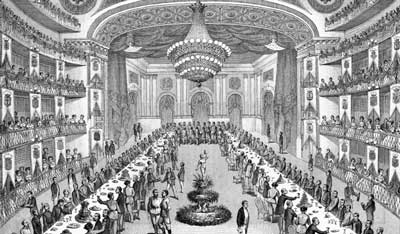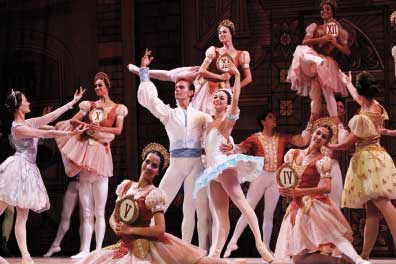 Although the art of ballet has a long and rich history in Europe, its appearance in Cuba dates from the late eighteenth century, conditioned by the social transformations that the country suffered as a result of the implementation of the policy of enlightened despotism. With regard to ballet that Spanish government policy influenced on two fundamental facts: the creation of the first theaters (Coliseo- Principal, 1776-1803), El Circo (1800) and Diorama (1829), which allowed the initial representations of the genre on the island, and the appearance of newsprint in Havana (1790), that gave us the documentary record, which began with the news about the release of Los leñadores on September 28, 1800, in El Circo theater, located in the grounds of the Campo de Marte, area located in the current Fraternity Park and the Capitol.
Although the art of ballet has a long and rich history in Europe, its appearance in Cuba dates from the late eighteenth century, conditioned by the social transformations that the country suffered as a result of the implementation of the policy of enlightened despotism. With regard to ballet that Spanish government policy influenced on two fundamental facts: the creation of the first theaters (Coliseo- Principal, 1776-1803), El Circo (1800) and Diorama (1829), which allowed the initial representations of the genre on the island, and the appearance of newsprint in Havana (1790), that gave us the documentary record, which began with the news about the release of Los leñadores on September 28, 1800, in El Circo theater, located in the grounds of the Campo de Marte, area located in the current Fraternity Park and the Capitol.
Although for almost four decades various foreign companies showed the Creoles a varied repertoire that included exponents of ballet action, pas de deux, pas de trois, solos and pantomimic and pastoral dances, it was not until the creation Tacon Theatre that the great ballet could be enjoyed on the island.
According to testimonies and documents of the time, Don Miguel Tacon, general captain of the island since 1834, gave a series of facilities to Don Francisco Marty and Torrens, a wealthy Catalan, who had made a fortune with the business of fish and slave trade, for him to build this theater. For this he gave all the necessary stone from the quarry of the Government, and agreed on six masked balls for his own benefit and the free labor of the prisoners, who were in charge of the construction work. Work began in August 1836, and concluded a year later, in a field located at the gates of the wall that surrounded the city of Havana, in the Monserrate and Paseo de Isabel II streets, today called Paseo del Prado, area near the old town and the new districts emerged in the called Extramural Havana.
Installation capacity was of five floors: two main boxes, one of third boxes and seats, one for social gathering and another of casserole, which could comfortably accommodate about three thousand spectators, as a profusion of windows and doors contributed to rapid access to it, as well as ventilation and evacuation. Although in outward appearance it lacked some majesty -a simple Doric portico and recessed arches and lacking statues, wealth and good taste of its ornamentation earned it the most enthusiastic praise, it was compared to its counterparts in Paris, London, Vienna, Milan and St. Petersburg.
Although inaugurated on February 18, 1838 with a masked ball, it quickly became the supreme place of scenic dance in Cuba, especially since the first season of the Ravel, famous company that offered in its stage performances that were extended until 1865. The continued work of Ravel as well as visits to the legendary Austrian dancer Fanny Elssler (1841-1842) of HippoliteMonplesir, star of the Paris Opera (1848 and 1850-1851) and other dance companies sets, especially Catalan and French, unveiled the best of romantic repertoire, the creations of famous choreographers such as Filippo Taglioni, Jules Perrot, Jean Coralli, Jean Aumer, Joseph Mazilier and Arthur Saint-Leon.
After a long break, caused by our wars of independence and the crisis that the European art ballet suffered after the heyday of Romanticism, the activities of ballet in Cuba returned to find an appropriate framework at the National Theatre, a name acquired the Coliseo after the establishment of the Republic, on May 20, 1902. After its capital repair in 1915 which made it become part of the empire of the Galician Center of Havana, the great Russian ballerina Anna Pavlova revived a tradition there with her performances in the seasons of 1917 and 1918 to 1919, where she enriched the dance culture of Cubans with representative works of classical style, emerging from the creative talent of MariusPetipa and Lev Ivanov and revolutionary reforms of ballet implemented in the early twentieth century by the also Russian Mijail Fokine.
Another important milestone that marked the presentation in that theater in 1930 was the Paris Opera Priveé, composed of Russian singers and dancers, which performed the premiere in Cuba, on January 21 of that year, the Swan Lake, by Tchaikovsky, in a mise en scène in which Nikolai Yavorski took part, who later would become the director of the Ballet School of the Musical Society Pro-Arte in Havana and the first teacher of Alicia, Alberto and Fernando Alonso.
The today National Ballet of Cuba, then under its first name: Ballet Alicia Alonso, in an effort to bring art of ballet to all sectors of the nation, began on February 24, 1950 a series of popular features in that theater , which extended during the months of March, April and June, in which the cast, led by the Cuban prima ballerina, released a varied repertoire which included classics like Giselle, the second act of Swan Lake, Coppelia, The Nutcracker, the Marriage of Aurora, the Don Quixote pas de deux, Pas de quatre, as well as contemporary creations as Les Sylphides, Apollo, Polovtsian Dances, the Spectre of the Rose, the Dying Swan, Peter and the Wolf, Party and Symphonic Essay.
 A decade later the National Ballet returned to that stage, by then called Teatro Estrada Palma, during the celebration of the 1st. International Ballet Festival of Havana, in which Giselle and Coppelia were presented, on March 23 and 26, 1960 respectively, centralized by the Alonso.
A decade later the National Ballet returned to that stage, by then called Teatro Estrada Palma, during the celebration of the 1st. International Ballet Festival of Havana, in which Giselle and Coppelia were presented, on March 23 and 26, 1960 respectively, centralized by the Alonso.
On April 8, 1965 our main dance group returned to the stage, called García Lorca since 1961, for the premiere of a new production of Swan Lake, with Alicia Alonso and Rodolfo Rodriguez in the central roles. Thereafter, this historical stage became its permanent theatrical venue and it has starred events of the highest artistic and historical shaft, as were the celebrations of the International Festival of Havana, from 1966; Jubilees for the 35th anniversary of the debut of Alicia Alonso in the title role of Giselle (1978), the 50th anniversary of her stage debut as a dancer (1981), the 30th anniversary of Mirta Pla (1983), Josefina Mendez and Loipa Araújo (1985 ), Aurora Bosch (1986), Marta Garcia (1987) and Maria Elena Llorente (1989), and deliveries of its Annual Award to relevant national and international figures which have contributed to its extraordinary prestige.
In its rich history, the theater has hosted prestigious foreign ballet ensembles, including the Twentieth Century Ballet of Maurice Bejart (1968); the Independent Ballet of Mexico (1969), the Classic Ballet of France (1970), the Kirov Ballet of Leningrad (1972), the Romanian Ballet of Bucharest (1976), Les Grands Ballets Canadiens (1977) and the Permanent Ballet of Theater Colón of Buenos Aires (1990).
From March 2, 1980, the Coliseo changed its name again, this time by the Grand Theater of Havana, as the core of a cultural complex directed by Alicia Alonso in the period 1981-1991, which included concert halls, lectures, film festivals, arts galleries and alternative spaces for theatrical performances of different genres.
In its 177 year history, the glory of the Tacón-Gran Teatro de La Habana is kept alive. We joyfully celebrate on the occasion of the forthcoming reopening that will have its main hall and the rest of the units that comprise it, after a total restoration by the Ministry of Culture which has attracted the admiration of all Cubans.










